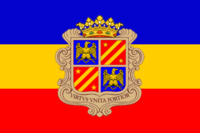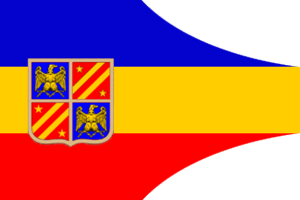Andorra

| |
| Official Language | Catalán |
| Capital | Andorra la Vella |
| Prince | Napoleó VII |
| Prime Minister | |
| Area | 214 mi² |
| Population | 69,150 |
| Official Religion | Catholicism |
| Currency | Lliura |
| National Anthem | El Gran Carlemany |
Andorra is the last independent survivor of the so-called Marca Hispanica, several buffer states created by Charlemagne to keep the Muslim Moors from advancing into Catholic France, as well as the present seat of the Bonaparte Dynasty, descendants of a younger brother of Napoleon. Tradition holds that Charlemagne granted a charter to the Andorran people in return for their fighting the Moors. In the 800s, Charlemagne's grandson, Charles the Bald, named the Count of Urgell as overlord of Andorra. A descendant of the count later gave the lands to the Diocese of Urgell, headed by the Bishop of Urgell.
History
In the 11th century, fearing military action by neighboring lords, the bishop placed himself under the protection of the Lord of Caboet, a Catalan nobleman. Later, the Count of Foix became heir to the Lord of Caboet through marriage, and a dispute arose between the French count and the Catalan bishop over Andorra.
In 1278, the conflict was resolved by the signing of a pareage (pariatges), which provided that Andorra's sovereignty be shared between the Count of Foix and the Bishop of La Seu d'Urgell (Catalonia). The pareage, a feudal institution recognizing the principle of equality of rights shared by two rulers, gave the small state its territory and former political form.
Over the years the title passed to the kings of Navarre, and under the king of France, Henry IV, an edict in 1607 established the head of the French state and the Bishop of Urgell as co-princes of Andorra, a state which lasted (with a few small exception) until 1923.
In 1870, Napoleon III of France was deposed. As part of the agreement by which he stepped down, he was permitted to keep the title of Co-Prince of Andorra, which he passed to his son after his death in 1873.
Napoleon IV spent much of his time plotting to recover France. He died a broken man in 1903, passing the principality to his 11-year-old son, Napoleon V.
Napoleon V had given up the notion of recovering France and was more interested in developing his native Andorra. Upon reaching his majority in 1910, he formally renounced interest in France and began taking the reigns of power, still relying heavily on his advisors. By his mid-20s, he began coming into his own and formally began talks with the Bishop of Urgell in 1920. These talks resulted, in 1923, in an agreement whereby the Bishop would cede his political power in Andorra, while retaining ecclesiastical authority.
Economy
Currency
The de jure currency of Andorra is the lliura, part of the European Federation Currency Union, but the Aragonese escudo and the French livre are the main currencies found in circulation, as the small minting of Andorra's mint are quickly acquired by collectors.
Bonaparte Dynasty
Until 1923, the Bonapartes shared rule of Andorra with the Catholic Bishop of Urgell in Aragon.
| Name | Reign | Life | Notes |
| Napoleon I | 1806-1821 | 1769-1821 | Also Emperor of France, Holy Roman Emperor, and King of the RTC |
| Napoleon II | 1821-1832 | 1811-1832 | Emperor of France, 1821-1830 |
| Napoleon III | 1832-1873 | 1808-1873 | Emperor of France, 1848-1870 |
| Napoleon IV | 1873-1903 | 1856-1903 | |
| Napoleon V | 1903-1964 | 1892-1964 | Sole Prince of Andorra from 1923 |
| Napoleon VI | 1964-1985 | 1922-1985 | |
| Enric | 1985-1997 | 1925-1997 | Brother of Napoleon VI |
| Napoleon VII | 1997- | 1953- |
A source of pride for the Andorrans and puzzlement for outsiders, the Andorran Merchant Navy is one of the largest in the world. Not only does this seem unusual to most due to the relatively small size of the country (and population), but the fact that it is landlocked and lacking in large seaways would seem to prevent its very existence.
In truth, next to no ships that fly the Andorran merchant ensign are actually crewed by any of its citizens or indeed have owners that have been to the principality even once. The reason for this state of affairs can be traced back to Prince Napoleon V and his economic projects.
Largely dependent on Aragonese and French Merchants for oversea trade, the Prince came upon the idea of offering registration in his country to any ships who agreed to pay a minimal one-off payment, offer free transport of a certain number of Andorran officials (based on tonnage and duration) and allow transport of local goods at a discount. In exchange, the ships were not required to abide by any specific regulations (apart from maritime laws), maintain cargo manifests or fear being impressed in time of war.
This measure proved quite popular and shipping companies flocked to obtain their Andorran registration. The number of ships steadily climbed during the 1930s and then jumped during the Second Great War as companies from warring countries changed registration to allow trading as neutral ships, since Andorra had not declared war on Germany.
It should be noted that while the modern fleet's reputation for barely sea-worthy hulks might be deserved by some ships, the vast majority were registered mostly to avoid paying large taxes and salaries or to legally engage in traffic forbidden in their homelands, for example, the transport of banned goods or side-stepping trade embargoes.
Some observers have perceived another, perhaps subconscious reason for the Prince's creation. Being constitutionally prevented from creating an army, this could be the closest the House of Bonaparte will ever come to having a large, uniformed force at its service. While the world may never see another conquering Napoleonic army, the ensign of "Napoleon's Fleet" has, over the years, flown in the ports of every continent.
